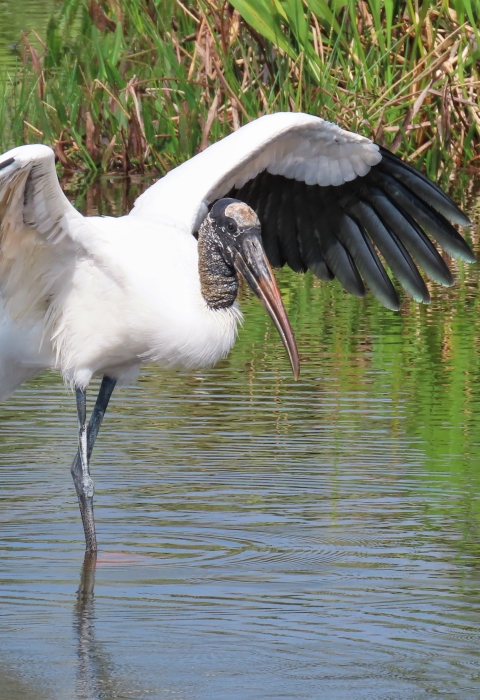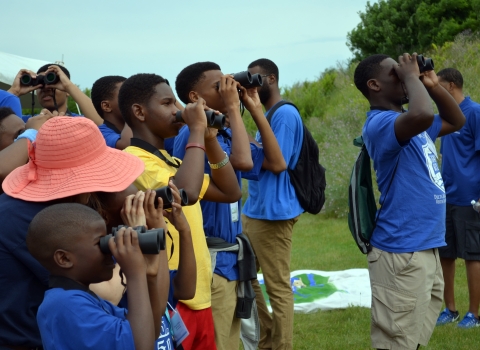TOWNSEND, GA – Secretary of the Interior Sally Jewell today announced that the U.S. Fish and Wildlife Service is down-listing the wood stork from endangered to threatened under the Endangered Species Act (ESA), reflecting a highly successful conservation and recovery effort spanning three decades. Jewell made the announcement at the Harris Neck National Wildlife Refuge, home to the largest wood stork rookery in Georgia.
“The down-listing of the wood stork from endangered to threatened demonstrates how the Endangered Species Act can be an effective tool to protect and recover imperiled wildlife from the brink of extinction, especially when we work in partnership with states, tribes, conservation groups, private landowners, and other stakeholders to restore vital habitat,” Secretary Jewell said. “From the cypress swamps of Georgia, to the inland waterways of Florida, wetlands and their wildlife are emblematic of the American Southeast. Through important conservation partnerships, the U.S. Fish and Wildlife Service is working to rebuild a healthy wetland ecosystem, which, in turn, is helping restore the wood stork’s habitat, double its population since its original listing and keep the bird moving in the right direction toward recovery.”
“We are thankful for the great efforts of our conservation partners who are helping us shepherd this remarkable species toward recovery,” said U.S. Fish and Wildlife Service Director Dan Ashe. “Reclassification of the wood stork to threatened status does not diminish protection measures for the bird under the ESA, and we will continue to work with our partners to fully recover the bird, including with our counterparts in Florida, South Carolina and Georgia, and great organizations like Ducks Unlimited and the Corps of Engineers.”
The ESA has been enormously successful in conserving imperiled wildlife, preventing the extinction of more than 99 percent of the species listed as threatened or endangered since 1973. In addition, 27 species have been delisted due to recovery, including the bald eagle, American alligator, and peregrine falcon. Others, such as the whooping crane and the California condor, have been pulled back from the edge of extinction. Meanwhile, 30 species have been down-listed from endangered to threatened. Under the ESA, a species is considered endangered when it is at risk of extinction throughout all or a significant portion of its range. It is considered threatened when it is at risk of becoming endangered throughout all or a significant portion of its range.
When wood storks were listed as endangered in 1984, their population was dropping a precipitous 5 percent a year. Since then, the U.S. breeding population has shown substantial improvement in the numbers of nesting pairs as a whole and an expansion of its breeding range.
Since 2004, the three-year averages (2003 to 2012) for nesting pairs ranged from 7,086 to 10,147, all above the 6,000 three-year average identified in the 1997 recovery plan as the threshold to consider reclassifying the species to threatened status. However, the five-year average of 10,000 nesting pairs, identified in the current recovery plan as the threshold for delisting, has not yet been reached.
When the Service originally listed the U.S. breeding population, the wood stork’s range included Florida, Georgia, South Carolina and Alabama. Breeding was primarily in Central and South Florida. Historically, the Florida Everglades and the Big Cypress ecosystems supported large breeding colonies. Since listing, its range has expanded north and west, and now includes portions of North Carolina and Mississippi, with significant nesting in Florida, Georgia, South Carolina and North Carolina.
The down-listing of the wood stork to threatened status follows a comprehensive review by Service biologists of the best available scientific and commercial information about the wood stork’s status as required by the ESA, and after peer and public reviews, that shows conservation efforts under the Act have helped increase populations and reduce threats.
The down-listing recognizes the wood stork’s ongoing recovery and the positive impact that collaborative conservation efforts over the last two decades are having on the status of the breeding population. With continued population growth, breeding range expansion and the minimization or removal of threats, the species could approach the biological milestones where it could be considered for delisting.
The Service continues to work with conservation partners such as the Natural Resources Conservation Service through its Wetlands Reserve Program, to protect natural wetlands and manage public lands to continue the recovery of the wood stork. For example, the Wetlands Reserve Program has restored more than 200,000 acres of wetlands in Florida and more than 115,000 acres in Alabama, Georgia and South Carolina.
Addressing the threats associated with habitat loss, protecting natural wetlands through partnerships, managing public lands and restoring the Everglades, all remain high priorities for the Service and the Department. In addition, as new information emerges, climate change climate change
Climate change includes both global warming driven by human-induced emissions of greenhouse gases and the resulting large-scale shifts in weather patterns. Though there have been previous periods of climatic change, since the mid-20th century humans have had an unprecedented impact on Earth's climate system and caused change on a global scale.
Learn more about climate change adaptation measures will be considered to address changes that may be projected in the location of suitable habitat.
As part of the reclassification decision, the Service also determined that the stork’s U.S. breeding population is a “Distinct Population Segment” under the ESA, separate from wood storks that breed in Central and South America. The U.S. Distinct Population Segment is protected by the ESA and the Migratory Bird Treaty Act (MBTA). Populations breeding in Central and South America are not listed under the ESA, although wood storks in Mexico are protected by that country’s domestic equivalent to the MBTA, pursuant to Mexico's migratory bird treaty with the United States.
For high-resolution images of wood storks and their habitat at Harris Neck, please visit our photo albums on Flickr: Wood Storks at Harris Neck and Wildlife of Harris Neck.



